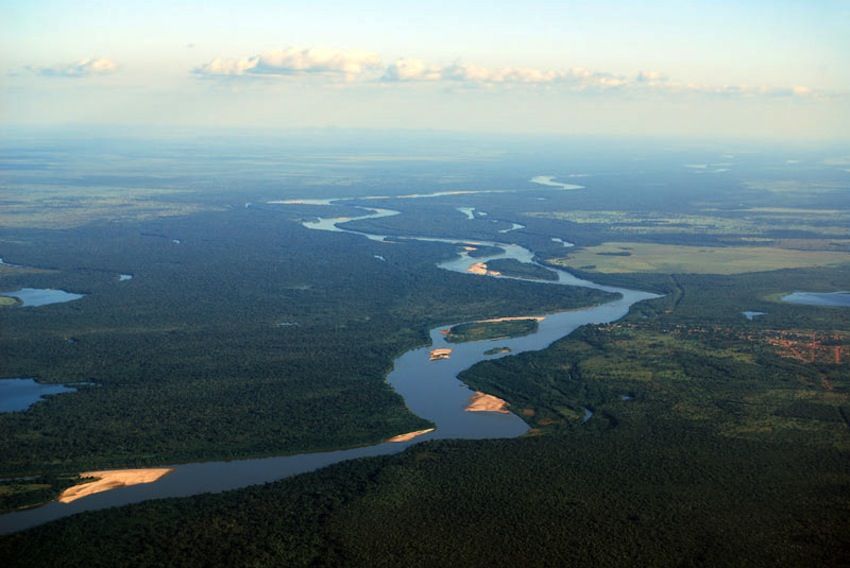Ancient Amazon Rainforest Was Once Used for Agriculture

The Amazon rainforest, often thought to have been pristine wilderness before the modern era, was once domesticated, and was reclaimed by the wild only in recent centuries, research increasingly suggests.
The Amazon, the world's largest river basin, is home to the largest rainforest on Earth, covering about 2.6 million square miles (6.7 million square kilometers) across nine countries. This area, known as Amazonia, holds an extraordinary array of life, harboring one in 10 known species in the world and one in five of Earth's birds.
Although the Amazon is often thought of as pristine nature, over the past few decades, archaeologists have discovered evidence of numerous large, complex societies that may have inhabited Amazonia in the past. While these findings contrast with the small Amazonian societies anthropologists investigated in the 20th century, they are in line with initial eyewitness accounts of Europeans from the 16th and 17th centuries. [Images: One-of-a-Kind Places on Earth]
To investigate what Amazonia was like before the European conquest, lead study author Charles Clement, a crop geneticist and historical ecologist at Brazil's National Institute of Amazonian Research in Manaus, and his colleagues collected data on the plants, soil and landscape of Amazonia, as well as projections of population sizes and maps of where Amazonian languages are spoken.
"It is consensus that central and southern Amazonia were well populated, with abundant domesticated plants, forests, landscapes and soils," Clement told Live Science.
At least 83 native Amazonian species were domesticated to some degree by the time of contact with Europeans, including sweet potato, cacao, tobacco, pineapple, cassava and hot peppers, as well as numerous fruit trees and palms. Another 3,000 to 5,000 plant species that were not domesticated were nevertheless used in some way, the researchers said. Although many present-day Amazonian forests may seem natural, research suggests they are domesticated to varying degrees, possessing different populations of plants than one would expect in a naturally biologically diverse forest.
Prior research also had discovered Amazonian dark earths — soils that are rich in nutrients and carbon resulting from human waste and fires, mulching and composting on farms. Sites rich in Amazonian dark earths may cover more than 0.1 percent of Amazonia, first appearing in parts of the Amazon 6,000 years ago and increasingly rapidly in number and size about 2,500 years ago, the researchers said.
Sign up for the Live Science daily newsletter now
Get the world’s most fascinating discoveries delivered straight to your inbox.
All together, farming on sites rich in Amazonian dark earths may have supported at least 8 million people in 1492, the researchers said. "When most people think about the grandeur of past Native American societies, they think of the Aztec, Maya and Inca pyramids," Clement said. "Native Amazonians did not have pyramids, perhaps because there was no stone. What most impressed the first Spanish adventurers were the large numbers of healthy, well-fed people, and the abundance of food in every community they visited in Amazonia. This convinced them that the soils were rich and that the native peoples knew how to manage them for food production."
Amazonia reverted to wilderness after Columbus arrived in the New World, Clement said. "The Colombian Encounter, as it is often called, resulted in the introduction of European, African and Asian diseases to which Native Americans had no immunity," he added.
For instance, smallpox, which is thought to have arrived in the Americas via a Spanish ship that landed in Mexico, devastated the Inca Empire, paving the way for its conquest by a handful of Spaniards, Clement said. "Within a century after the beginning of conquest, disease had wiped out 50 percent of the Native American populations," he said.
Although Amazonia reverted to wilderness after the decimation of its native peoples, Clement stressed that it doesn't mean the Amazon rainforest will return wherever modern society allows it to. "This is a fallacy because Native Amazonians did not clear-cut the forest, nor plant pastures and soy," Clement said. "We are not saying that modern society can clear-cut the forest for food production."
Future research can investigate "how the Native Amazonians could support complex societies without destroying the environment," Clement said. "We might learn something from Native Amazonians."
The scientists detail their findings online July 22 in the journal Proceedings of the Royal Society B.
Follow us @livescience, Facebook & Google+. Original article on Live Science.











